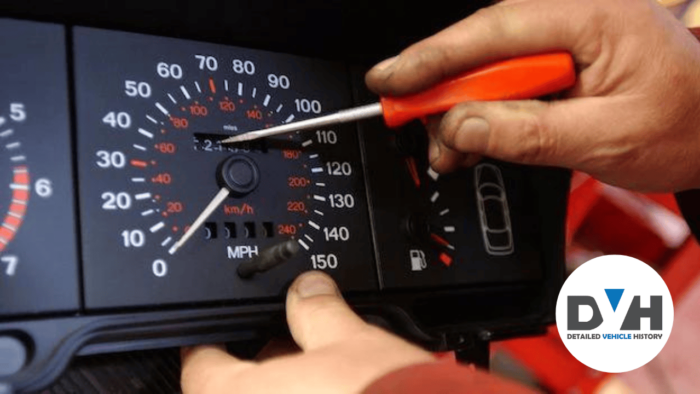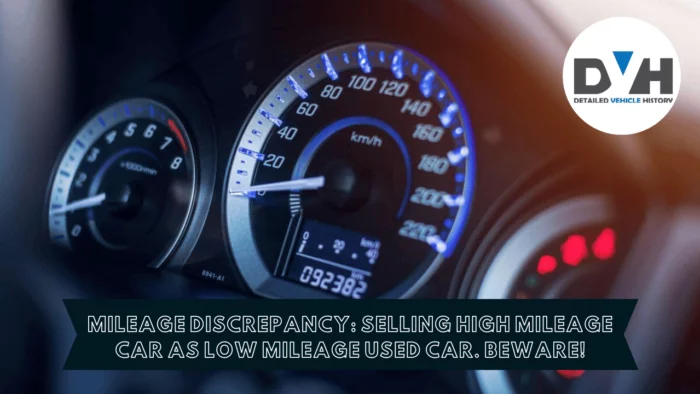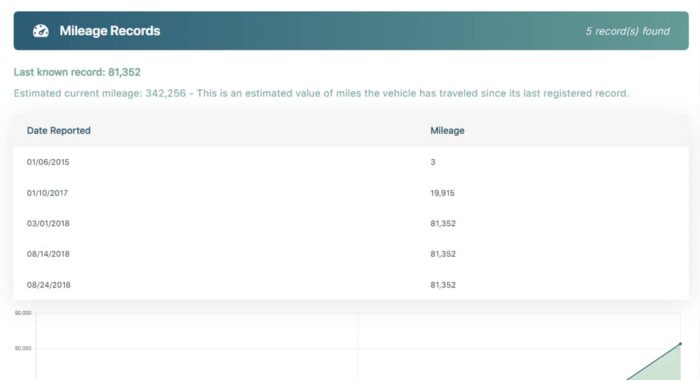You’ve discovered the ideal used car within your budget, boasting low mileage displayed on the dashboard. However, appearances can be deceiving. Did you realize that the actual mileage might be higher than what’s shown? Beware!
The National Highway Traffic Safety Administration (NHTSA) estimates over 450,000 vehicles are sold annually with false odometer readings, costing buyers over $1 billion. Shockingly, 3.47% of a vehicle’s first 11 years often involve odometer rollback.
In this blog, we will dig into the common practice of odometer rollback in the used car market, equipping buyers with knowledge to safeguard themselves from falling prey to mileage discrepancies.
Mileage Discrepancy and Odometer Rollback: What's the Difference?
Car mileage represents the distance a vehicle has covered since its manufacture, typically falling between 12,000 to 19,000 miles annually. Higher figures are deemed high mileage.
Odometer readings, recorded on the odometer, track this distance. However, in the used car market, where low mileage enhances appeal, some sellers engage in deceptive practices known as mileage discrepancy or odometer rollback. This involves tampering with the odometer to falsely portray less mileage, a tactic termed “clocking” in the U.S. and “busting miles” in Canada, the U.K., and Ireland.
This fraudulent act aims to create an illusion of lower vehicle usage, emphasizing the importance of vigilance among used car buyers to avoid falling victim to such schemes.

Odometer Rollback: Why it's a Common Practice Among Some Used Car Sellers?
The prevalence of odometer rollback in the secondhand car market can be attributed to a simple yet lucrative motive – to maximize profits.
By tampering with the odometer, sellers can present a heavily-worn car as if it’s a low-mileage used car, enabling them to command a higher price. For instance, a 2015 Toyota Camry with 150,000 miles might fetch $10,000, but the same car with 300,000 miles could be deceptively sold for $7,500. Unscrupulous dealers may view this manipulation as an effortless way to pocket an extra $2,500, illustrating the unethical practices some adopt to exploit unsuspecting buyers in pursuit of financial gain.
Understanding this motive emphasizes the importance of carefulness and thorough inspection and odometer check by VIN lookup when considering a used car purchase.
Why Used Car Buyers and Sellers Need to Care About Odometer Rollback
A report by Carfax stated that odometer fraud from rolling back odometers rose in 2022 by 7%, a figure that keeps rising. Aside from the fact that this translates to a loss of about $4000 per vehicle with a rolled-back odometer, many of the victims (used car buyers and sellers) are not aware they have been scammed.
Find out more below about why you need to care:
- Overpayment: If you unknowingly purchase a vehicle with an odometer rollback, you likely paid more than the actual value. Odometer fraud can lead to considerable financial losses.
- Trade-in Issues: Trading in a vehicle with an odometer rollback becomes challenging. Dealerships rely on VIN check reports, and any hint of fraudulent mileage could result in them rejecting your trade-in.
- Selling Woes: Private sellers require full disclosure of odometer discrepancies. Prospective buyers are unlikely to invest in a vehicle with a history of tampered mileage.
- Maintenance Expectations: High-mileage cars may necessitate component replacements. Automatic transmission failure is common around 100,000 miles, demanding a change. Routine replacements of the timing belt, water pump, and fuel pump are expected for high mileage vehicles, considering these components have a lifetime measured by mileage.
Overall, being vigilant about odometer rollback is crucial for both buyers and sellers to avoid financial setbacks and ensure fair transactions in the used car market.
How to Detect and Avoid Odometer Fraud on a Car for Sale
Odometer fraud remains one of the disadvantages of selling and buying a used car. This is one of the several reasons why many car buyers would still prefer buying a new car over a used or older car from a dealership if they are financially capable. Therefore, detecting odometer fraud in a used vehicle is crucial to ensure you’re making an informed purchase.
Here are several ways to identify potential odometer rollback and not be at disadvantage:
- Check the car’s history report: Obtain a comprehensive history report that shows the car’s mileage at various points in its history. If the current odometer reading is significantly lower than previous reports, it raises a red flag.
- Look for signs of wear and tear: Examine the car for any visible wear and tear, both inside and out. If the vehicle shows excessive signs of aging that don’t align with the odometer reading, it could indicate manipulation.
- Check the car’s service records: Regular service records should document the car’s mileage at each service. If the current odometer reading is noticeably lower than the service records indicate, it suggests potential odometer tampering.
- Check for inconsistencies during test drives: Pay close attention to the odometer reading during test drives. If you notice sudden jumps or skips in the reading, it may signal odometer tampering.
- Inspect for physical tampering: Physically inspect the odometer for signs of tampering. Ensure the numbers are readable, aligned without gaps, and match the original specifications. Misaligned or altered numbers and discrepancies in dashboard screws may indicate odometer manipulation. Thorough scrutiny of these aspects enhances your ability to detect and avoid mileage-related deception when purchasing a used car.
Is Odometer Rollback legal?
No, odometer rollback is illegal under both federal and state laws in the United States. The Truth in Mileage Act (TIMA) was introduced in 1986 to enforce truthful disclosure of vehicle mileage on advertisements and titles. Sellers are prohibited from tampering with odometers to misrepresent a vehicle’s condition. Odometer fraud has been a federal crime since 1972, further solidifying the legal consequences for such actions.
If you discover that your vehicle’s odometer has been rolled back, you have legal rights. Victims of odometer fraud have the right to pursue legal action against the perpetrator. In a successful case, the court can award damages of $10,000 or three times the actual damages, whichever is greater. Additionally, the defendant is responsible for covering your attorney fees and court costs.
Recognizing the financial risks and harm to unsuspecting buyers, the federal government has taken a strong stance by declaring odometer tampering a federal crime under Title 49 U.S. Code 32703. The law explicitly prohibits individuals from altering or disconnecting odometers to manipulate their readings.
Use Case: Odometer Rollback Detection and Cost Saving With Detailed Vehicle History VIN Check Service
Mr. Michael sought to purchase a used 2012 Honda Civic in Ottawa costing up to $9,230 but needed to verify the odometer reading due to concerns about thin cracks on the dashboard. The goal was to detect any potential odometer rollback and determine the accurate market value for the vehicle for a fair purchase.
Mr. Michael discovered the Detailed Vehicle History website through a Google search. He navigated to the VIN check page and entered the VIN: 2HGFB2F97CH001914.
Making a payment of $15, a cost-effective solution compared to competitors like Carfax, Mr. Michael was impressed with the unique VIN check service.
Within minutes, he generated the report and identified an odometer rollback from 206,000 km to 135,000 km, explaining the dashboard cracks.
The Detailed Vehicle History report was able to provide an accurate mileage timeline, enabling Mr. Michael to negotiate a lower price with confidence. He purchased the car, saving up to $3,500 by avoiding potential issues associated with the odometer rollback.
This use case underscores the invaluable role of VIN check technology in ensuring transparency and informed decision-making in the used car market. View the vehicle history report indicating odometer fraud
Conclusion
Despite the introduction of digital odometers, odometer rollback remains a persistent issue, infiltrating the used car market and making it challenging for buyers to find trustworthy vehicles. Year after year, this deceitful practice grows, posing a threat to those seeking reliable used cars.
However, there are preventive measures for both buyers and reputable dealers. Conducting a thorough vehicle history check, especially through a paid VIN check service, proves more beneficial than risking overpayment for a car with hidden issues and unforeseen maintenance costs.
Detailed Vehicle History reports provide accurate chronological odometer readings, eliminating the possibility of mileage discrepancies. By investing in such checks, buyers can navigate the used car market with confidence, steering clear of potential red flags and ensuring a more secure purchase.
Frequently Asked Questions
How much mileage is too much for a used car?
It depends on the car’s age and maintenance. Generally, aim for less than 15,000 miles per year. Higher mileage might mean more wear, but a well-maintained car can still be good.
Is it hard to sell a car with high mileage?
Selling a high-mileage car can be a bit challenging, but it depends on the condition. If well-maintained, there are buyers who look for affordable options.
Buying a Used Car: Does Mileage Matter?
Yes, mileage matters. Lower mileage often means less wear and tear. Consider the car’s age, maintenance history, and your usage needs when deciding.
Is it Bad to Buy a Used Car With Unusually Low Mileage?
Unusually low-mileage car buying might indicate low miles and long periods of inactivity, which can lead to potential problems. It’s essential to check the car’s condition, maintenance, and reasons for low odometer reading.
What are the risks of buying a used car with low mileage?
The risks of buying used cars with lower odometer reading may include engine problems from prolonged inactivity, aging of rubber components, and potential hidden issues. Thorough inspection and history check are crucial.
How does the number of miles affect the trade in value of a car when dealing with used car lots?
The number of miles significantly influences the trade-in value of a car when dealing with used car lots. Generally, lower mileage tends to result in a higher trade-in value, as it suggests less wear and tear, making the vehicle more appealing to potential buyers.
What's the connection between the age and mileage of a car when considering the hassle of selling a used car privately?
When dealing with the hassle of selling a used car privately, the age and mileage of the vehicle are closely connected. Older cars with higher odometer reading might be perceived as having more wear and tear, potentially making them harder to sell privately. Buyers often seek low-mileage cars for better reliability and longevity, reducing the challenges associated with selling a used car privately.











